|
|
|
|
The Ultra Tec Owners' Newsletter
Summer 1984
"The Some Times"
|
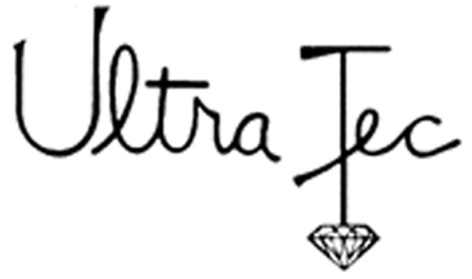
|
|
Dear Ultra Tec Owner,
Greetings again from Ultra Tec! This is another in our series of when
we-get-around-to-it newsletters.
There is not too much show news to report in the summer--most of the show
activities are in the cooler months. This past July (yes, it was HOT),
however, brought us the California Federation Show, this year in combination
with the American Federation. It was in San Diego at the Convention Center,
a very nice facility. Since it was only about 100 miles from us, it was like
old-home week, but we did meet a few people from out of state.
One of the bright spots for us was a chance to visit with Earl and
Ann Manor
who had set up their faceting equipment and were demonstrating. Both Earl
and Ann have Ultra Tecs (isn't that the right way?) and do a lot of teaching
in the San Diego area. They had two very nice cases set up - one was an
educational case showing the steps in faceting and the other a case of their
work. In the latter case there was a new square cut design that Ann has
developed, and it was extraordinary. Look for that design in a future issue
of the 'Lapidary Journal'. Earl, who is an engineer, gave us some good
ideas to think about (one of his ideas appears later in this letter).
|
|
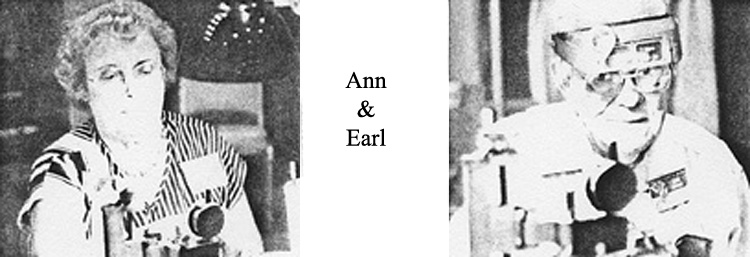
|
Another highlight of the show was seeing Ultra Tec Facetor,
Glenn Klein, who won the traditional Johansen Award. The award is
given in a Three Stone Competition. In winning, Glenn scored 78 out of 80
possible points for workmanship. The winning cuts were a Capriccio Cushion
Cut in white YAG, a Hexagonal Star in blue Spinel, and a Square Brilliant
Synthetic Ruby. This is hardly the first time a major faceting award has
brought Glenn's photo to these pages (and most likely not the last).
We also had a chance to visit with Donn Law, who several weeks
earlier had won a Five Stone Competition at the San Diego County Fair. It
took a little coaxing to get that story from him, but he was obviously proud
of his achievement. It was his first entry into competition, and you can
imagine how good it feels to start out that way. Donn is an Ultra Tec
Facetor, who works in his family's lapidary shop, The Rock Farm, in San
Marcos.
|
|
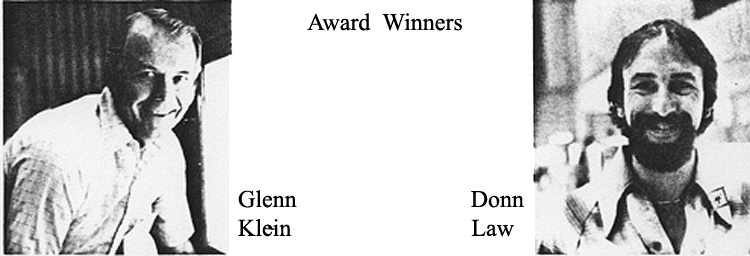
|
In the Best Case competition, the first position went to our old friend,
Vern Johnson, with Glenn Klein as runner-up. It was easy to see the
admiration for these two exceptional cases on the part of the viewers. Those
gentlemen are both prior Ultra Tec Award winners, and it seems to be the
fate of Ultra Tec Award winners to eventually win the national Federation
award. I didn't have a chance to see Vern after the judging was announced,
so I take this chance to send my congratulations. I did have a chance to
'swap lies' with him earlier in the show and I think I won that contest.
Right around the corner, along with cooler weather is the Southern California
Faceters' Fair in Long Beach, at the Rochelles' Convention Center on September
8th and 9th. Not long after that is the Big Sky Show in Great Falls, Montana,
on October 6th and 7th. And it's probably not too soon to plan for the
International Faceters' Fair in San Jose, CA, January 26-27,1985.
There are no dramatic product announcements this time around, but there are
some new things of interest which I think are in the very-nice category.
DOWN-INDICATOR LIGHT
The first is an idea which came to us by way of several facetors who have
rigged similar devices onto their machines. It is a 'Down-Indicator Light'
(OK, you try to name it), which lights up when the angle stop makes contact.
To a certain extent it is like the Dial Indicator Attachment - that is, the
indicator light going on corresponds to the Dial Indicator reading zero (if
you leave the mechanical stop engaged). Of course, the Down-Indicator doesn't
give all the information or the flexibility that the Dial Indicator offers.
The Down-Indicator does have a degree of accuracy that surprised us, however,
showing a sensitivity of .0001 inch (2.5 microns) which was as far as we took
the testing, so it is very good for accuracy. As the final position is
approached, the light starts to flash - what it is showing are the 'hills and
valleys' of the lap. Stopping at the first flashings is one way to do it.
Even more accuracy can be obtained by waiting until the light is ON steadily,
showing that a full down position has been reached. Even if the Dial Indicator
Attachment does the job for you, it is nice to have an extra 'warning device'
which attracts attention if you are looking away from the indicator. And, it is
something which eases the work on your eyes-always welcomed. Nicely, the price
of this device is comparatively easy to take, and there is a special
first-time-around price which shares the savings of the higher volume of first
orders. See the enclosed Product Bulletin.
PUMP UNIT
Another new thing is a Pumping Unit - there is a description in the
accompanying literature. As you know some design ideas are prompted by
Industrial users and are passed along to amateurs and semi-pros (and
frequently the other way around). This time the impetus came from Industrial
users. One of the things that Industrial users complained about was the need
to replenish the drip tank, particularly when under steady use. I don't think
it is a problem for most people, but it might be for some (for example, those
who are not located close to their supply of water or who may be waking
someone else up if you are given to late night faceting). The Pumping Unit
has a one gallon capacity (four times the capacity of the drip tank). It
comes with a faucet and an adapter fitting which fits into the Base Plate,
using the same hole that the Water Tank post uses. There was a temptation
to make the tank larger, but we used the gallon capacity since most people
use a one gallon jug as a drain reservoir. Matching those capacities eliminates
the overflow problem at the drain bottle; when it is time to refill the pump,
it is time to empty the drain.
Unfortunately, good quality pumps, fittings, holding tanks, cases, etc. are
expensive, and the price of this unit is $230. - that was OK for commercial
users who convert their time into money, but is probably steep for most
facetors. We have it, however, and I expect that some of you may be
interested. Availability may be limited since I imagine these would be
made on an as-ordered basis, and mostly for commercial users.
If you have thought about plumbing your unit directly, incidentally, the
faucet that comes with the pumping unit can be obtained separately. If you
need to know more about it, send us a note and ask. Permanent plumbing,
incidentally, would not restrict the portability of your unit, since the
faucet can be removed very easily and the Water Tank post reinstalled.
POLIFLOW
You may remember the name of Dr. Henry Owens (who designed the O'Henry
Cut of a few letters back). Dr. Owens has been interested in the
grinding and polishing process and has developed a water additive which
has been named Poliflow. This speeds and improves the effectiveness of
the process.
Studies have shown that the polishing process, when using oxides (cerium,
aluminium, etc.) is primarily a chemical process. Sparing you the details
of the chemistry, it is enough to know that the additive really works to
help the process along. It cleans the lap quickly, both grinding and
polishing and incidentally, lap life. Functioning as a wetting agent,
it reduces the amount of water flow that is necessary to about 1/3 to
1/5 the normal rate. Although it is an expensive additive, it goes a
long way.
Reports that we have gotten from professional facetors who have evaluated
the additive indicate it is very good and often changes a stubborn
polishing stone to a fast easy-one. Reg Thompson, who many of you know
for his writings on faceting and his faceting designs, is one of the
people who performed evaluation and continues to use it. If you would
like to try Poliflow, we will sell one bottle on an introductory basis
for $2.50. After September 15th the price will remain the same, but will
be sold in six packs for $15.00. And if you understand what the paperwork
shuffle is like you will understand the reason for that.
NEW BOOK
There is also a new book from Long and Steele. It is Volume Five and
deals with round stones. This is still another volume in the popular
series that started several years ago. And, again, they bring this
volume to us at a very low price.
|
QUADRANT GEAR
During my last spurt of faceting I fished through my box of "old stuff"
and came up with a 96 "quadrant gear". It was something that was
started years ago by Howard Stanley. Those of you who remember Howard
surely knew him to be a very logical person in his approach to faceting.
The illustration shows you what it would take quite a few words to describe.
It is a very logical gear, and of great assistance to anyone who does
designing of gem cuts. The logic of the gear also assists in the cutting
of a similar design, repeatedly. It allows you to memorize the design very
quickly (without really trying).
|
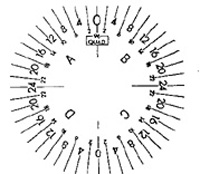
|
The only flaw - and it is not the fault of the quadrant gear - is that
instructions are written for continuously numbered gears. For any
symmetrical design, however, the instruction for the first quadrant
would be the same for the remaining three quadrants, and I found that
I caught on very quickly. I liked it (and those of you 'in on the know'
understand that the decision on whether we manufacture some item depends
mostly on whether I like it). So, we will be making some of these. You will
note the price is higher than our standard gears which we make in comparatively
large quantities.
TIPS
After the San Diego Show, Earl Manor sent us the following information
about cutting Cabochons on the Ultra Tec. I thought we would pass it
along. The following is a quote from Earl:
The Ultra Tec is a wonderful machine for faceting gems, but Ann
Manor of La Mesa, CA also uses her Ultra Tec to produce fine
cabochons. This is the method she has developed.
Stones are dopped on wooden dop sticks and are shaped on diamond bonded
laps. It may take a getting the hang of it, but she says it is just as
easy to shape a stone against a flat horizontal cutting surface as against
a cylindrical vertical wheel. After progressing through successively finer
laps we come to the really different part of her method.
A series of laps are made using 1/4" thick tempered masonite, 8" in diameter
with a 1/2" center hole. A 1/4" thick sponge rubber disc is cemented to the
back side of the masonite disc with rubber cement. (Sponge rubber discs are
available from most lapidary supply firms). On the rubber is placed a
"Crystalite" CRYSTALPAD (adhesive backed). These laps are then charged with
diamond compound in grit sizes from 260 to 100,000. Using these successively
the cabochon can be brought to an exceptionally fine surface. For the final
stage of polishing, instead of a Crystalpad Ann uses a suede-like Polypad,
and for polishing opal and softer stones she uses Cerium Oxide. For jade use
Linde "A" or "B", and for corundum (mainly star stones), she finishes them
with a 100,000 grit diamond spray.
For best results in cutting jade cabochons, Ann has found it best to omit
the sponge rubber under the Crystalpad, this eliminates the tendency of
jade to "orange-peel" in polishing.
Here's a sound idea passed along to us by Gil Decker. For any of a
variety of reasons you may choose to interrupt the faceting of a stone. If
that interruption includes the removal of the Index Gear, you will want to
get the Index Gear reassembled in the same lateral position. That can be
done by aligning your 45 degree adapter so it is square to the Index Gear
before you remove it, and then reversing the procedure when you reinstall
the gear, that is, before tightening the screw that holds the Index Gear,
on the reinstallation, first line up the 45 degree adapter on the lap and
then tighten the screw.
As you know when I recommended Ultra Laps for polishing, I have alerted you
to the bit of edge rounding that occurs. I felt the rounding was absolutely
insignificant unless you were cutting for competitive purposes. In a
conversation at the show, however, Glenn Klein reported that he got very
good edges using Ultra Laps if he used the adhesive type rather than using
water to hold the lap. That makes sense since the layer of water would be
a cushion. So, those of you who might be cutting competitive stones may
wish to reconsider Ultra Laps.
An idea sent to us by Bob Steele of South Bend, Indiana was to use the
top end of the lamp shade on your machine as a dark field illuminator for
viewing gem rough. It works--and it doesn't get lost like special devices do.
In our prior newsletter there was a tip about realigning a stone that had been
knocked off the dop. H. E. Hood of Orange, Texas wrote to us about it
and pointed out that a felt tip pen (of the permanent-marking, not the water
soluble type) is an excellent way to mark a facet so you can see how it is
making contact on the lap. I have found this type of pen is very handy when
working on an intricate stone with small facets as it helps confirm that I
am making contact where I think I am. (Now, that is an embarrassing thing to
admit). But I bet I'm not the only person who that happens to, and who can
benefit from the felt tip pen.
To wrap this up before we ramble on to another page, we have just a bit of
miscellany: If you send your machine in for calibration or repair, please
include a short note. Do that even if you have had a conversation with someone
before sending it. We do keep notes of those conversations and we have a place
to keep them, but guess what? Factory calibration, incidentally, barring some
unusual complication is $30.00.. ..If you live in the area of Redding, CA and
want to make contact with a faceting group, get in touch with Bob Moulton
. Bob is relatively new to Redding, but he is an eager facetor who provides
lessons. His phone number is 916/243-9096....Here at UltraTec we have a new
member of the team. His name is Gus Munoz....And now we really have to
sign off, so that we leave room for a gem design on the other side of this
page.
So long for now.
|
| : |

|
Norm Stone Designs the 'WHICH WAY UP' cut
|
|
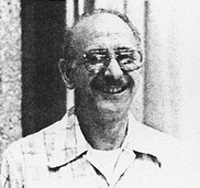
|
Norm Stone can always be trusted to have something special to
show - usually at the San Jose Faceters' Fair where we see him each year.
First comes the mischievous smile and then--"do you want to see something
nice?" Last show's "something nice" really was--and I asked Norm for the
cutting instructions. Here they are. No, there's no diagram to look at and
I'm not quite sure how I'd draw it--it's a 3-sider and each side the same?
Here's Norm's words about it: I call this my "which way is up?" Tri-Quad.
Actually it's a step cut Tetrahedon, but Tri-Quad is briefer.
|
The idea for the cut originated in my trying to come up with an unusual
design to be cut and put in the San Francisco Gem & Mineral Society's
Showcase in memory of our deceased member and former Faceting Instructor,
Joe Campton. After cutting several stones (none of them particularly unique),
I thought of a triangle, but what is unique about a triangle??? Then I got
the idea for making all sides equal. That I thought was unique. The prototype
took approx. 4 weeks from concept to finished stone, as I had to fine tune the
angles and indexes to make the stone come out equilateral on all faces.
Following are the cutting instructions:
Tri-Quad
120 Index
Angles for ALL materials
Inasmuch as this is a deep stone, a very light coloured material
is advisable.
Flat Lap one side of stone and dop on flat side.
PAVILION CUTTING INSTRUCTIONS
Step Angle
Index
Remarks
1 70.5
120-40-80
Preform
2 56.4
14-26-54-66-94-106
Until approx 60% of table width
3 44.5
20-60-100
Just enough for Girdle thickness
4 59.5
9-111-31-49-71-89
Level girdle
5
Polish in the reverse order
CROWN CUTTING INSTRUCTIONS
A briolette dop is suggested
Step Angle
Index
Remarks
1 82.5
0-40-80
Fix girdle width
2 67.5
0-40-80
3 54.5
0-40-80
4 42.5
0-40-80
5 27.0
0-40-80
6
Polish in the reverse order
Note: It may be necessary to adjust any or all of the above angles, in order to
keep the facets parallel.
|





